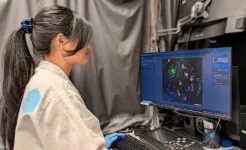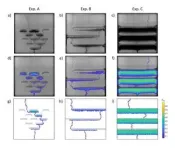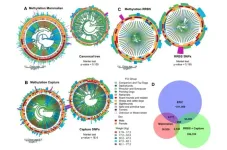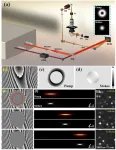Brain’s support cells contribute to Alzheimer’s disease by producing toxic peptide
Targeting oligodendrocytes could help reduce amyloid beta production
2024-07-23
(Press-News.org) Oligodendrocytes are an important source of amyloid beta (Aβ) and play a key role in promoting neuronal dysfunction in Alzheimer’s disease (AD), according to a study published July 23, 2024 in the open-access journal PLOS Biology by Rikesh Rajani and Marc Aurel Busche from the UK Dementia Research Institute at University College London, and colleagues.
AD is a devastating neurodegenerative disorder affecting millions of people worldwide. Accumulation of Aβ – peptides consisting of 36 to 43 amino acids – is an early critical hallmark of the disease. Recent clinical trials demonstrating a slowing of cognitive and functional decline in individuals with AD who are treated with anti-Aβ antibodies reinforce the important role of Aβ in the disease process. Despite the key cellular effects of Aβ and its essential role in AD, the traditional assumption that neurons are the primary source of toxic Aβ in the brain has remained untested.
In the study, Rajani and Busche showed that non-neuronal brain cells called oligodendrocytes produce Aβ. They further demonstrated that selectively suppressing Aβ production in oligodendrocytes in an AD mouse model is sufficient to rescue abnormal neuronal hyperactivity. The results provide evidence for a critical role of oligodendrocyte-derived Aβ for early neuronal dysfunction in AD. Collectively, the findings suggest that targeting oligodendrocyte Aβ production could be a promising therapeutic strategy for treating AD.
According to the authors, the functional rescue is remarkable given the relatively modest reduction in plaque load that results from blocking oligodendrocyte Aβ production, while blocking neuronal Aβ production leads to a near elimination of plaques – another hallmark of the disease. This small contribution of oligodendrocytes to plaque load could suggest that a main effect of oligodendrocyte-derived Aβ is to promote neuronal dysfunction.
Together with the data showing an increased number of Aβ-producing oligodendrocytes in deeper cortical layers of the brains of individuals with AD, these results indicate that oligodendrocyte-derived Aβ plays a pivotal role in the early impairment of neuronal circuits in AD, which has important implications for how the disease progresses and is treated. The increased number of oligodendrocytes in human AD brains also raises the intriguing possibility that these cells could potentially offset reduced Aβ production due to neuronal loss as the disease progresses.
The authors add, “Our study challenges the long-held belief that neurons are the exclusive source of amyloid beta in the brain, one of the key toxic proteins that builds up in Alzheimer's Disease. In fact, we show that oligodendrocytes, the myelinating cells of the central nervous system, can also produce significant amounts of amyloid beta which impairs neuronal function, and suggests that targeting these cells may be a promising new strategy to treat Alzheimer's Disease.”
#####
In your coverage, please use this URL to provide access to the freely available paper in PLOS Biology: http://journals.plos.org/plosbiology/article?id=10.1371/journal.pbio.3002727
Citation: Rajani RM, Ellingford R, Hellmuth M, Harris SS, Taso OS, Graykowski D, et al. (2024) Selective suppression of oligodendrocyte-derived amyloid beta rescues neuronal dysfunction in Alzheimer’s disease. PLoS Biol 22(7): e3002727. https://doi.org/10.1371/journal.pbio.3002727
Author Countries: United Kingdom, United States
Funding: see manuscript
END
ELSE PRESS RELEASES FROM THIS DATE:
2024-07-23
“In this study, we explore the potential of the three largest, publicly available DNA methylation datasets in dogs to identify signals of biological age.”
BUFFALO, NY- July 23, 2024 – A new research paper was published in Aging (listed by MEDLINE/PubMed as "Aging (Albany NY)" and "Aging-US" by Web of Science) Volume 16, Issue 13, entitled, “Co-analysis of methylation platforms for signatures of biological aging in the domestic dog reveals previously unexplored confounding factors.”
Chronological age reveals the number of years an individual has lived since birth. By contrast, biological age varies between individuals of the same chronological ...
2024-07-23
BINGHAMTON, N.Y. -- A research team led by faculty from Binghamton University, State University of New York has been exploring how mass layoffs and data breaches could be connected. Their theory: since layoffs create conditions where disgruntled employees face added stress or job insecurity, they are more likely to engage in risky behaviors that heighten the company’s vulnerability to data breaches.
The research, outlined in a paper titled “The Impacts of Layoffs Announcement on Cybersecurity Breaches,” was presented by Binghamton ...
2024-07-23
Nearly 40 million adults in the U.S. have sleep apnea, and more than 30 million of them use a continuous positive airway pressure (CPAP) machine while sleeping. However, the machines tend to be expensive, clunky and uncomfortable — resulting in many users giving up on using them.
High blood pressure is often linked with sleep apnea because the brain works harder to regulate blood flow and breathing during sleep. A recent study at the University of Missouri offers new insight into the underlying mechanisms within the brain contributing ...
2024-07-23
Abu Dhabi, July 22, 2024: A team of researchers at NYU Abu Dhabi, led by Professor Sehamuddin Galadari, has discovered that the tumor suppressor protein Prostate apoptosis response-4 (Par-4) can cause a unique type of cell death called ferroptosis in human glioblastoma – the most common and aggressive type of brain tumor – while sparing healthy cells. This new understanding has the potential to inform the development of novel treatments for various hard-to-treat cancers and neurodegenerative diseases.
Ferroptosis is triggered by the iron-mediated production of reactive ...
2024-07-23
(BOSTON) – Donald M. Lloyd-Jones, MD, ScM, has accepted the position of director of the Framingham Center for Population and Prevention Science, principal investigator of the Framingham Heart Study, and chief of the section of preventive medicine within the department of medicine at the Chobanian & Avedisian School of Medicine and Boston Medical Center, effective January 1, 2025.
Lloyd-Jones is the chair of preventive medicine and Eileen M. Foell Professor of Heart Research and professor of preventive medicine, medicine and pediatrics at Northwestern University. He previously served as senior associate dean for clinical and translational ...
2024-07-23
A new publication from Opto-Electronic Advances; DOI 10.29026/oea.2024.240064, discusses advanced phase-controlled 3D biochemical imaging.
Three-dimensional (3D) imaging provides deep insights into understanding of complex biological and biomedical systems, which offers far more detailed information than traditional 2D methods. A standout in this field is nonlinear optical microscopy, particularly coherent Raman Scattering (CRS) microscopy (e.g., coherent anti-Stokes Raman scattering (CARS) and ...
2024-07-23
Johannes Gutenberg University Mainz (JGU) has established a new junior professorship in the field of Earth System Science, supported by funding provided by the Volkswagen Foundation, Germany's largest private, non-profit organization engaged in the promotion and support of academic research. This Junior Professorship for High-Resolution Sedimentology is part of the JGU Institute of Geosciences and held by Dr. Igor Obreht. He will be creating a unique lab for high-resolution imaging for the analysis of terrestrial and marine sediments that formed thousands to millions of years ago. The resulting data will ...
2024-07-23
A new publication from Opto-Electronic Advances; DOI 10.29026/oea.2024.230202 , discusses an all-optical ultra-long-distance image acquisition and transmission system.
With the exponential growth of data globally, the demand for high-speed acquisition and long-distance transmission of multidimensional data is escalating. Online video surveillance in sectors like industrial manufacturing has significantly boosted productivity while mitigating security risks. Real-time global video calls have revolutionized people's daily lives. Existing systems can leverage ...
2024-07-23
A new publication from Opto-Electronic Advances; DOI 10.29026/oea.2024.240099 discusses an on-chip spectrometer with high performance, low power-consumption and simple control logic.
The miniaturized spectrometer has emerged as a powerful tool for analytical applications, particularly due to its promising potential in portable settings. These devices are increasingly integral in various sectors, including health monitoring functions on wearables like smartwatches and food quality inspections through smartphones.
Traditionally, ...
2024-07-23
Psychologists have used the hit TV series Game of Thrones to understand how the brain enables us to recognise faces.
Their findings provide new insights into prosopagnosia or face blindness, a condition that impairs facial recognition and affects approximately 1 in 50 people.
The researchers scanned the brains of over 70 study participants as they watched footage from the popular TV series. Half of the participants were familiar with the show’s famously complex lead characters and the other half had never seen the series.
When lead characters appeared on screen, MRI scans showed that in neurotypical ...
LAST 30 PRESS RELEASES:
[Press-News.org] Brain’s support cells contribute to Alzheimer’s disease by producing toxic peptide
Targeting oligodendrocytes could help reduce amyloid beta production








